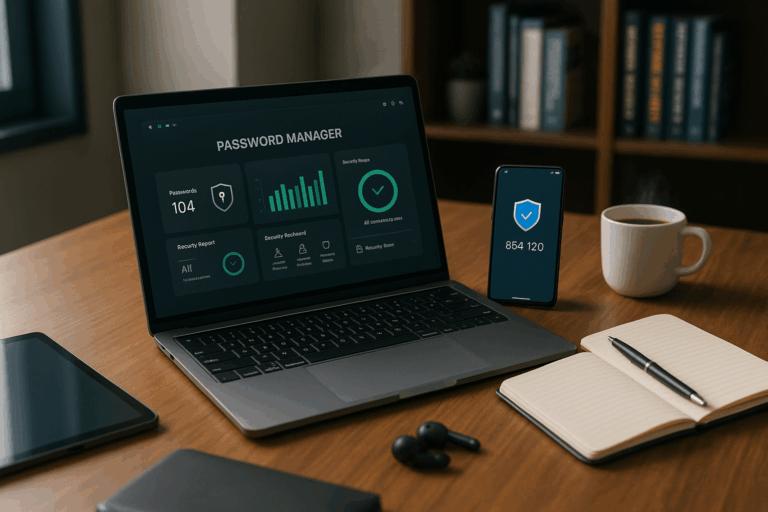The main focus of today’s discussion? Two-Factor Authentication (2FA). In the rapidly evolving digital landscape, 2FA has emerged as a powerful weapon against unauthorized access, significantly bolstering online security.
Why is this system so vital, you may ask? 🧐 Well, let’s put it this way. Your online accounts are like your home. Would you feel secure with just one lock on your door when the risk of burglary has surged? Probably not. Hence, the additional layer of security – another lock, if you will, provided by 2FA, is essential. But, how exactly does it work? That’s what we’re here to explore.
What’s on the Agenda?
In this comprehensive guide, we’ll delve deep into the realm of two-factor authentication, shining a light on its importance, working mechanism, and the role it plays in fortifying online security. We’ll start with the basics, explaining what 2FA is, followed by an in-depth look at how it functions, and then discuss its benefits and importance in protecting your online data. 💼
Additionally, we’ll address some of the common misconceptions surrounding 2FA and provide a walkthrough on how to enable it on various platforms. To further illuminate the significance of 2FA, we’ll delve into some real-world examples, highlighting instances where 2FA has been a savior and scenarios where its absence led to regrettable consequences.
Why You Should Stay With Us
As you traverse the digital world, leaving footprints in the form of personal and professional data, it becomes crucial to understand how to safeguard this information. Misuse of such data can lead to not just privacy invasion, but also financial and reputation loss. 😟
Yet, despite the palpable danger, a large number of internet users remain oblivious to the benefits of extra security layers like 2FA. Some perceive it as an unnecessary complication, while others underestimate the risk they’re exposed to. This guide aims to change that, empowering you with the knowledge and tools to take your online security to the next level.
If you’re a novice in the digital security realm, fear not. We’ll break down complex concepts into digestible information. If you’re well-versed with the subject, this guide will provide new insights and reinforce your existing knowledge. 🧑🎓
A Sneak Peek into What’s Ahead
Just to whet your appetite, we’ll talk about different types of 2FA, including something as simple as an SMS code to more sophisticated methods like biometric authentication. We’ll also touch upon the concept of multi-factor authentication (MFA), which takes security even further.
In a nutshell, this guide will be your roadmap to understanding and implementing two-factor authentication, ensuring you’re not just double, but multiple times safer in the digital universe. So, buckle up, and let’s embark on this informative journey together! 🔐
🔐 Unveiling the Digital Fortress: Understanding Two-Factor Authentication
From the most casual internet user to the most tech-savvy cybersecurity professional, there’s a common ground: the importance of online security. And the first line of defense in this realm? That’s right – it’s your passwords. But in a world where data breaches and cyber-attacks are more frequent than ever, just having a strong password isn’t enough anymore. Enter two-factor authentication (2FA). But what is 2FA, and why is it so important for your online security? Let’s dive in and find out.
At its core, two-factor authentication adds an extra layer of security to your online accounts. It achieves this by requiring not just one, but two types of identification before you can access your account. Traditionally, this has been something you know (your password) and something you have (a unique code sent to your mobile device).
Many of you might already be familiar with 2FA, even if you don’t recognize the term. If you’ve ever logged into a website and been asked to enter a code sent to your mobile phone, that’s two-factor authentication in action. And it’s this extra step that makes 2FA so effective at keeping your online accounts secure.
🎯 The Double Shield: How Two-Factor Authentication Works
The premise of two-factor authentication is straightforward. When you enter your username and password, that’s the first step of the authentication process. This is something you know, and it’s your primary form of identification. But two-factor authentication doesn’t stop there. After you’ve entered your password, you’ll then be asked to provide a second form of identification – this is the ‘two-factor’ part.
Typically, this second factor is a unique code that’s sent to your mobile device. This is something you have, and it’s a form of identification that’s much harder for hackers to get hold of. Even if they’ve somehow managed to discover your password, they’ll still need this second form of identification to access your account. This makes 2FA a highly effective form of online security.
To provide a practical understanding, take a look at this illustrative video “What is Two-Factor Authentication? And why you should use it?” by Techquickie on YouTube. It offers a quick, informative, and easy-to-understand guide on how 2FA works.
🛡️ Suiting up for Cybersecurity: Why Two-Factor Authentication is Essential
With the basics of two-factor authentication out of the way, let’s take a closer look at why it’s so essential for your online security. In a nutshell, two-factor authentication is all about adding an extra layer of security. It’s that simple – but it’s also that effective. By requiring two types of identification, 2FA makes it much harder for unauthorized users to gain access to your online accounts.
But the importance of two-factor authentication goes beyond just making it harder for hackers. It’s also about awareness. When you have 2FA enabled, you’ll usually be alerted whenever someone tries to log into your account. So even if a hacker does manage to get hold of your password, you’ll be notified before they can do any damage.
Another key benefit of two-factor authentication is that it’s relatively easy to implement. Most major online platforms offer some form of 2FA, and it’s usually just a case of enabling it in your account settings. This makes it a simple, yet effective way to enhance your online security.
🥊 Battle of the Beasts: Comparing Different Forms of Two-Factor Authentication
| Form of 2FA | Pros | Cons |
| SMS-Based | Easy to set up, widely supported. | Can be intercepted, dependent on mobile service. |
| App-Based (e.g., Google Authenticator) | More secure than SMS, still relatively easy to use. | Requires installation of an additional app, can be inconvenient to access. |
| Hardware Tokens | Very secure, not dependent on mobile service. | Can be lost or stolen, more expensive to implement. |
For a more in-depth comparison and guide on these forms, “The Pros and Cons of Two-Factor Authentication Types and Methods” by Tripwire, Inc on YouTube is an excellent resource.
🚀 Boost Your Shields: Implementing Two-Factor Authentication
Now that we’ve explored the what, why, and how of two-factor authentication, it’s time to look at how you can implement it to boost your online security. As mentioned earlier, most major online platforms offer some form of 2FA, so the first step is to check if it’s available on the platforms you use. If it is, enabling it is usually as simple as ticking a box in your account settings.
However, it’s important to remember that two-factor authentication isn’t a silver bullet for online security. While it adds an extra layer of protection, it’s not foolproof, and it should be used in conjunction with other security measures. This includes things like using strong, unique passwords, regularly updating your software, and being aware of phishing scams.
Ultimately, two-factor authentication is an essential tool in your online security toolkit. It’s easy to implement, it adds a crucial extra layer of protection, and it helps keep you aware of any unauthorized attempts to access your accounts. So if you’re not using two-factor authentication already, it’s time to start. Your online security is too important to leave to chance.

Conclusion
In conclusion, it is clear that the world of Information Technology and Engineering is ever-evolving and never static. We have delved into various technical concepts, ranging from software development methodologies to the nitty-gritty of network security, machine learning, artificial intelligence, and data analysis. The recurring theme throughout has been the pivotal role that these technologies and concepts play in shaping our digital world. 🌐
Let’s take a quick recap on some of the points we have covered. First, we discussed the importance of software development methodologies like Agile and Scrum, which revolutionize the software production process to create more efficient, reliable, and user-friendly products. These methodologies not only provide a blueprint for developers but also ensure that software products meet the ever-changing needs of users and the market. 💻
Next, we examined the intricacies of network security, exploring its importance in protecting sensitive data from cyber threats. With our lives so entwined with the digital realm, there is an urgent need for robust security measures to safeguard our personal and business information.
We also delved into machine learning and artificial intelligence, elucidating how they are transforming industries from healthcare to finance. These technologies are not just about automating tasks, they represent a new frontier in technology where machines can learn, adapt, and even make decisions. 🤖
Finally, we discussed the power of data analysis and how it is shaping business strategies and decision-making processes. We live in an era where data is the new gold, and those who can mine it effectively have a distinct competitive advantage. 📈
Throughout the article, we have sought to demystify these complex concepts, illustrating how they work, their benefits, and potential applications. Our aim has been to provide you with a comprehensive understanding of these technical areas, so you can apply this knowledge in your professional or personal life.
The significance of these topics cannot be overstated. They are integral to our digital age and understanding them is key to navigating our increasingly interconnected world. Therefore, we encourage you to delve deeper, to share this knowledge with others, and to engage in the conversation about these exciting technological developments.
Remember, this article is a gateway to a much broader and deeper world of IT and engineering knowledge. For further reading, you might want to check out these articles on [Software Development Methodologies](https://www.cprime.com/resources/what-is-agile-what-is-scrum/), [Network Security](https://www.cloudflare.com/learning/security/), [Machine Learning](https://www.ibm.com/cloud/learn/machine-learning), [Artificial Intelligence](https://www.microsoft.com/en-us/research/area/artificial-intelligence/) and [Data Analysis](https://www.sas.com/en_us/insights/analytics/what-is-data-analysis.html).
Thank you for accompanying us on this journey of exploration. We look forward to your comments, questions, and insights. Don’t forget to share this article with others who might find it valuable. Let’s continue to learn and grow together in this fascinating digital era. 💡🚀
Reference: cprime, cloudflare, ibm, microsoft, sas



